Multimodal effects of local context on target detection: evidence from P3b
- PMID: 18702574
- PMCID: PMC2823841
- DOI: 10.1162/jocn.2009.21071
Multimodal effects of local context on target detection: evidence from P3b
Abstract
We used the P300 component to investigate how changes in local context influenced the ability to detect target stimuli. Local context was defined as the occurrence of a short predictive series of stimuli before delivery of a target event. EEG was recorded in 12 subjects during auditory and visual sessions. Stimuli were presented in the center of the auditory and visual field and consisted of 15% targets (1000 Hz tone or downward facing triangle) and 85% of equal amounts of three types of standards (1500, 2000, and 2500 Hz tones or triangles facing left, upward, and right). Recording blocks consisted of targets preceded by either randomized sequences of standards or by sequences including a three-standard predictive sequence signaling the occurrence of a subsequent target event. Subjects pressed a button in response to targets. Peak target P300 (P3b) amplitude and latency were evaluated for targets after predictive and nonpredictive sequences using conventional averaging and a novel single-trial analysis procedure. Reaction times were shorter for predictable targets than for nonpredicted targets. P3b latency was shorter for predicted targets than for nonpredictive targets, and there were no significant P3b amplitude differences between predicted and random targets, as determined by both conventional averaging and single-trial analysis. Comparable effects on amplitude and latency were observed in both the auditory and visual modalities. The results indicate that local context has differential effects on P3b amplitude and latency, and exerts modality-independent effects on cognitive processing.
Figures
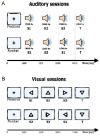

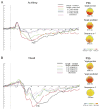

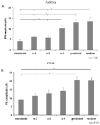

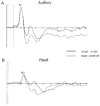
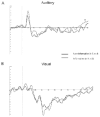

Similar articles
-
Local contextual processing of abstract and meaningful real-life images in professional athletes.Exp Brain Res. 2012 May;219(1):27-36. doi: 10.1007/s00221-012-3064-1. Epub 2012 Mar 20. Exp Brain Res. 2012. PMID: 22430185
-
Prefrontal cortex is critical for contextual processing: evidence from brain lesions.Brain. 2009 Nov;132(Pt 11):3002-10. doi: 10.1093/brain/awp230. Epub 2009 Aug 27. Brain. 2009. PMID: 19713281 Free PMC article.
-
Electrophysiological evidence for aging effects on local contextual processing.Cortex. 2010 Apr;46(4):498-506. doi: 10.1016/j.cortex.2009.05.007. Epub 2009 May 20. Cortex. 2010. PMID: 19559410 Free PMC article.
-
Local contextual processing effects with increasing stimulus presentation rate.Brain Topogr. 2011 Jan;23(4):385-91. doi: 10.1007/s10548-010-0160-z. Epub 2010 Aug 18. Brain Topogr. 2011. PMID: 20717841
-
Assessing cross-modal target transition effects with a visual-auditory oddball.Int J Psychophysiol. 2018 Jul;129:58-66. doi: 10.1016/j.ijpsycho.2018.04.010. Epub 2018 Apr 30. Int J Psychophysiol. 2018. PMID: 29723555
Cited by
-
Local contextual processing of abstract and meaningful real-life images in professional athletes.Exp Brain Res. 2012 May;219(1):27-36. doi: 10.1007/s00221-012-3064-1. Epub 2012 Mar 20. Exp Brain Res. 2012. PMID: 22430185
-
Human electrophysiological correlates of learned irrelevance: effects of the muscarinic M1 antagonist biperiden.Int J Neuropsychopharmacol. 2012 Nov;15(10):1375-85. doi: 10.1017/S1461145711001647. Epub 2011 Nov 18. Int J Neuropsychopharmacol. 2012. PMID: 22094124 Free PMC article. Clinical Trial.
-
Prefrontal cortex is critical for contextual processing: evidence from brain lesions.Brain. 2009 Nov;132(Pt 11):3002-10. doi: 10.1093/brain/awp230. Epub 2009 Aug 27. Brain. 2009. PMID: 19713281 Free PMC article.
-
Implicit versus explicit local contextual processing.PLoS One. 2013 Jun 13;8(6):e65914. doi: 10.1371/journal.pone.0065914. Print 2013. PLoS One. 2013. PMID: 23785458 Free PMC article.
-
Electrophysiological evidence for aging effects on local contextual processing.Cortex. 2010 Apr;46(4):498-506. doi: 10.1016/j.cortex.2009.05.007. Epub 2009 May 20. Cortex. 2010. PMID: 19559410 Free PMC article.
References
-
- Alain C, Hargrave R, Woods DL. Processing of auditory stimuli during visual attention in patients with schizophrenia. Biological Psychiatry. 1988;44:1151–1159. - PubMed
-
- Barcelo F, Knight RT. An information-theoretical approach to contextual processing in the human brain: evidence from prefrontal lesions. Cerebral Cortex, 2007. 2007;17 1:i51–60. - PubMed
-
- Barcelo F, Suwazano S, Knight RT. Prefrontal modulation of visual processing in humans. Nature Neuroscience. 2000;3:399–403. - PubMed
-
- Barch DM, Carter CS, Braver TS, Sabb FW, MacDonald A, Noll DC, et al. Selective deficits in prefrontal cortex function in medication-naive patients with schizophrenia. Archives of General Psychiatry. 2001;58:280–288. - PubMed
-
- Chao LL, Nielsen-Bohlman L, Knight RT. Auditory event-related potentials dissociate early and late memory processes. Electroencephalography and clinical Neurophysiology. 1995;96:157–168. - PubMed
Publication types
MeSH terms
Grants and funding
LinkOut - more resources
Full Text Sources
Miscellaneous

